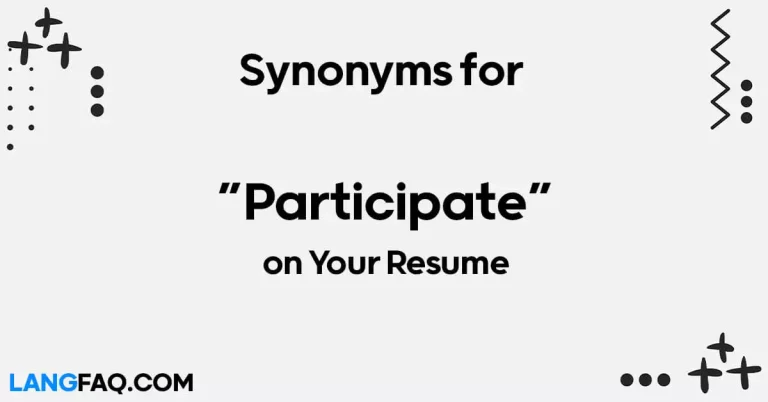Communication is a key aspect of our daily lives, and often, we find ourselves needing different ways to convey a message formally. In this article, we delve into 12 diverse expressions that can be used as alternatives to the common phrase “This Is to Inform You.” Enhance your language skills and make your messages stand out with these compelling alternatives.
12 Other Ways to Say “This Is to Inform You”
Here are 12 alternative ways to express “This Is to Inform You”:
- In Reference to Your Inquiry
- Sharing Important Updates
- Requiring Your Immediate Attention
- Notification of Significant Changes
- Drawing Your Attention To
- Conveying This Information To You
- Informing You Accordingly
- For Your Consideration
- Bringing to Your Notice
- Sharing Pertinent Details
- Notifying You Accordingly
- Alerting You To This Information
| Alternative Expression | Meaning | Example |
|---|---|---|
| In Reference to Your Inquiry | Responding to a specific question or request | “In reference to your inquiry about our services…” |
| Sharing Important Updates | Disseminating crucial information or changes | “We are sharing important updates regarding the project timeline.” |
| Requiring Your Immediate Attention | Urgently demanding the recipient’s prompt focus | “This matter requires your immediate attention.” |
| Notification of Significant Changes | Informing about noteworthy modifications | “This serves as a notification of significant changes in our policies.” |
| Drawing Your Attention To | Directing focus towards a particular matter | “We are drawing your attention to the upcoming event.” |
| Conveying This Information To You | Communicating specific details to the recipient | “We are conveying this information to you for your awareness.” |
| Informing You Accordingly | Providing information in alignment with the context | “I am informing you accordingly based on the latest developments.” |
| For Your Consideration | Requesting thoughtful attention and contemplation | “Please find the attached proposal for your consideration.” |
| Bringing to Your Notice | Making someone aware of a particular detail | “We are bringing to your notice the discrepancy in the report.” |
| Sharing Pertinent Details | Communicating relevant and significant information | “We are sharing pertinent details related to the upcoming project.” |
| Notifying You Accordingly | Alerting with respect to the context or situation | “Notifying you accordingly about the schedule changes.” |
| Alerting You To This Information | Drawing attention to important details | “We are alerting you to this information for immediate action.” |
These alternative expressions provide a versatile range of ways to convey information formally, allowing for more nuanced and varied communication styles. Whether you’re responding to inquiries, sharing updates, or notifying about changes, these alternatives offer a refined and sophisticated approach to formal communication.
Is It Correct to Say “This Is to Inform You”?
The phrase “This Is to Inform You” is grammatically correct and commonly used in formal communication to convey information. It is a standard and polite way to begin a message or notification, particularly in written correspondence such as emails, letters, or official announcements.
When to Use “This Is to Inform You”:
- Formal Announcements: Use this phrase when making formal announcements or notifications. For example, informing someone about policy changes, updates, or important events.
- Example: “This is to inform you that there have been modifications to the company’s attendance policy.”
- Professional Correspondence: It is suitable for initiating official communication, especially when the content of the message is important and requires the recipient’s attention.
- Example: “This is to inform you that your application for the position has been received and is currently under review.”
- Policy Updates: When there are changes to rules, procedures, or guidelines, this phrase is effective in signaling that the recipient needs to be aware of the new information.
- Example: “This is to inform you of the recent updates to the safety protocols in the workplace.”
Pros of Using “This Is to Inform You”:
- Formality: The phrase adds a formal touch to your communication, making it appropriate for professional and official contexts.
- Clarity: It clearly signals the purpose of the message – to provide information – setting the tone for what follows.
- Politeness: It maintains a polite and respectful tone, which is crucial in business and formal communication.
Considerations and Tips:
- Context Matters: While suitable for formal communication, assess the context to ensure it aligns with the tone you want to convey.
- Variations: While “This Is to Inform You” is formal, variations such as those discussed in the previous sections can be used to add nuance to your messages.
- Avoid Redundancy: If used frequently, it might sound redundant. Mix it with other phrases to keep your communication varied and engaging.
Professional Mail Example With “This Is to Inform You”
Subject: Announcement – Changes to Company Meeting Schedule
Dear [Recipient’s Name],
I hope this email finds you well. This is to inform you of some adjustments to our company meeting schedule that will be effective starting next month.
Upon careful consideration and in response to valuable feedback from our team, we have decided to revise the frequency and format of our monthly meetings. The changes aim to streamline communication, enhance efficiency, and provide a more focused discussion on key agenda items.
Beginning [Date], our monthly meetings will now be held bi-weekly on [Day] at [Time]. This adjustment is designed to accommodate the dynamic nature of our projects and ensure that we address emerging priorities in a timely manner.
Additionally, we will be incorporating a more interactive format, allowing for increased participation and engagement from all team members. Your input and insights are crucial to the success of these sessions, and we believe this modification will foster a more collaborative and productive meeting environment.
Attached to this email, you will find the revised meeting schedule for your reference. We kindly ask that you update your calendars accordingly to reflect these changes.
We understand that adjustments to established routines can be challenging, but we believe that these changes will contribute positively to our overall work environment. Your flexibility and cooperation are highly appreciated as we work together to implement these improvements.
Should you have any questions or require further clarification, please do not hesitate to reach out to [Your Contact Information]. We value your dedication and commitment to our shared goals and look forward to the continued success of our team.
Thank you for your attention, and we appreciate your understanding as we strive to enhance our company’s communication practices.
Best regards,
[Your Full Name] [Your Position] [Your Company]
In Reference to Your Inquiry
Effective communication in professional settings often involves responding promptly and appropriately to inquiries. The phrase “In Reference to Your Inquiry” is a formal and respectful way to acknowledge and address specific questions.
Scenario: Imagine receiving an email from a potential client inquiring about your services. In your response, you can begin with this alternative to convey a sense of attentiveness and professionalism.
Example:
Subject: In Reference to Your Inquiry about Our Services
Dear [Client’s Name],
Thank you for reaching out to us with your inquiry about our services. We appreciate your interest and would be delighted to provide you with the information you are seeking…
Variations:
- Colleagues: “Regarding Your Inquiry”
- Friends: “About Your Question”
- Mentor-Mentee: “In Response to Your Query”
Grammar Tip: Ensure that the reference is specific and directly addresses the content of the inquiry.
Pros: Adds a formal touch, shows attentiveness, and sets a professional tone.
Cons: May sound overly formal in casual contexts.
Sharing Important Updates
When conveying significant information, framing it as an announcement adds a layer of importance and urgency. “Sharing Important Updates” is a versatile phrase suitable for various scenarios.
Scenario: You’re updating your team about a change in project deadlines. Using this phrase in your message adds gravity to the information.
Example:
Subject: Sharing Important Updates – Project Deadline Change
Dear Team,
I hope this message finds you well. I am writing to inform you about some important updates regarding the project deadlines…
Variations:
- Colleagues: “Updates You Should Know”
- Friends: “Important News to Share”
- Mentor-Mentee: “Noteworthy Developments to Discuss”
Dictionary Insight: “Update” – an act of bringing someone or something up to date.
Pros: Conveys the significance of the information, encourages attention, and sets a serious tone when needed.
Cons: May be perceived as too formal in casual conversations.
Requiring Your Immediate Attention
In situations demanding urgent focus, using a phrase that conveys immediacy is crucial. “Requiring Your Immediate Attention” emphasizes the urgency of the matter.
Scenario: You’re addressing a critical issue that needs urgent resolution. This phrase communicates the need for prompt action.
Example:
Subject: Requiring Your Immediate Attention – System Outage
Dear [Recipient’s Name],
I trust this email finds you promptly. We are currently facing a system outage that requires your immediate attention and expertise…
Variations:
- Colleagues: “Urgent Action Needed”
- Friends: “Need Your Quick Input”
- Mentor-Mentee: “Seeking Your Swift Assistance”
Grammar Insight: Use present continuous tense for a sense of immediacy.
Pros: Clearly communicates urgency, prompts swift action, and avoids ambiguity.
Cons: Should be reserved for genuinely urgent matters to maintain credibility.
Notification of Significant Changes
Navigating through transitions and ensuring everyone is informed is crucial in various contexts. “Notification of Significant Changes” serves as a formal and explicit way to convey alterations with importance.
Scenario: You are informing your team about changes in company policies. Using this phrase sets the tone for the gravity of the modifications.
Example:
Subject: Notification of Significant Changes – Policy Update
Dear Team,
I trust this message finds you well. I am writing to provide you with a formal notification of significant changes to our company policies…
Variations:
- Colleagues: “Informing About Important Changes”
- Friends: “Updates You Should Be Aware Of”
- Mentor-Mentee: “Guidance on Recent Changes”
Dictionary Insight: “Notification” – a formal statement or announcement.
Pros: Clearly communicates the importance of changes, maintains transparency, and minimizes confusion.
Cons: May be perceived as too formal for casual announcements.
Drawing Your Attention To
Precision in communication is often appreciated, especially when emphasizing a particular matter. “Drawing Your Attention To” offers a sophisticated way to ensure the recipient focuses on specific details.
Scenario: You want to ensure your colleagues are aware of a critical point in a document. This phrase helps you guide their attention.
Example:
Subject: Drawing Your Attention To – Key Information
Dear [Recipient’s Name],
As you review the attached document, I would like to draw your attention to a key section that outlines the upcoming changes in our project strategy…
Variations:
- Colleagues: “Highlighting Important Information”
- Friends: “Pointing Out Key Details”
- Mentor-Mentee: “Guiding Your Focus to Essential Points”
Grammar Tip: Use gerunds for a seamless flow.
Pros: Ensures recipients focus on specific details, adds a touch of formality, and aids in effective communication.
Cons: May be perceived as overly formal in casual contexts.
Conveying This Information To You
Maintaining a balance between formality and clarity is essential, especially when the context requires both. “Conveying This Information To You” offers a nuanced way to express the act of providing specific details.
Scenario: You’re writing an email to a client, sharing detailed information about a project. This phrase ensures clarity and professionalism.
Example:
Subject: Conveying This Information To You – Project Overview
Dear [Client’s Name],
I am pleased to be conveying this information to you regarding the comprehensive overview of our upcoming project…
Variations:
- Colleagues: “Sharing These Details With You”
- Friends: “Letting You Know About This”
- Mentor-Mentee: “Offering Guidance on This Topic”
Dictionary Insight: “Convey” – to communicate or make known.
Pros: Balances formality and clarity, indicates a thorough approach, and fosters understanding.
Cons: May sound overly formal in very casual communication.
Informing You Accordingly
Precision and appropriateness in communication are essential, especially when conveying information in alignment with the context. “Informing You Accordingly” strikes a balance between formality and clarity.
Scenario: You’re providing feedback to a colleague on a project. This phrase ensures that your message is communicated with the right level of formality and relevance.
Example:
Subject: Informing You Accordingly – Project Feedback
Dear [Colleague’s Name],
I wanted to take a moment in this email to be informing you accordingly about the recent developments and feedback on the ongoing project…
Variations:
- Colleagues: “Updating You Appropriately”
- Friends: “Letting You Know About This Matter”
- Mentor-Mentee: “Guiding You in Accordance with the Situation”
Grammar Tip: Use adverbs to convey the appropriate manner of the action.
Pros: Ensures the right level of formality, conveys information in alignment with the context, and fosters clear understanding.
Cons: May be perceived as too formal in very casual contexts.
For Your Consideration
When seeking thoughtful attention and contemplation, “For Your Consideration” is a phrase that conveys a level of formality and respect.
Scenario: You’re presenting a proposal to a client. This phrase encourages them to carefully think about the content you’re providing.
Example:
Subject: For Your Consideration – Proposal for [Project Name]
Dear [Client’s Name],
Attached herewith is the proposal for [Project Name] for your consideration. We believe this plan aligns with your requirements and vision…
Variations:
- Colleagues: “Requesting Your Review”
- Friends: “Take a Look at This”
- Mentor-Mentee: “Seeking Your Thoughtful Reflection”
Dictionary Insight: “Consideration” – careful thought, typically over a period of time.
Pros: Encourages careful thought, adds a formal touch, and signals respect for the recipient’s judgment.
Cons: May sound overly formal in very casual settings.
Bringing to Your Notice
Acknowledging details with finesse is a hallmark of effective communication. “Bringing to Your Notice” adds a touch of sophistication to your messages.
Scenario: You’ve noticed a discrepancy in a report and want to ensure your colleague is aware of it. This phrase communicates your observation professionally.
Example:
Subject: Bringing to Your Notice – Discrepancy in Report
Dear [Colleague’s Name],
I hope this email finds you well. I am writing to bring to your notice a discrepancy in the financial report for the last quarter…
Variations:
- Colleagues: “Notifying You of an Observation”
- Friends: “Just Wanted to Point Out Something”
- Mentor-Mentee: “Guidance on an Important Detail”
Grammar Insight: Use gerunds for a seamless flow in professional communication.
Pros: Adds sophistication to communication, conveys professionalism, and ensures the recipient is aware of specific details.
Cons: May be perceived as overly formal in very casual contexts.
Sharing Pertinent Details
Effective communication often involves sharing information that is relevant and significant. “Sharing Pertinent Details” provides a formal and precise way to communicate specific information.
Scenario: You’re updating your team on crucial details related to an upcoming project. This phrase ensures that your communication is focused on essential information.
Example:
Subject: Sharing Pertinent Details – Project Milestones
Dear Team,
I trust this message finds you well. Today, I am sharing pertinent details regarding the upcoming milestones for our project…
Variations:
- Colleagues: “Providing Relevant Information”
- Friends: “Sharing Important Updates”
- Mentor-Mentee: “Guidance on Key Aspects”
Dictionary Insight: “Pertinent” – relevant or applicable to a particular matter.
Pros: Emphasizes the relevance of the information, maintains a formal tone, and ensures the focus is on key details.
Cons: May be perceived as too formal in casual conversations.
Notifying You Accordingly
When alerting someone with respect to the context or situation, “Notifying You Accordingly” is a phrase that conveys both formality and relevance.
Scenario: You’re informing a client about changes in project timelines. This phrase ensures your message aligns with the current situation.
Example:
Subject: Notifying You Accordingly – Project Schedule Adjustments
Dear [Client’s Name],
I am writing to notify you accordingly about the adjustments we have made to the project schedule due to unforeseen circumstances…
Variations:
- Colleagues: “Updating You in Accordance with Changes”
- Friends: “Just Wanted to Keep You in the Loop”
- Mentor-Mentee: “Guidance on Current Developments”
Grammar Tip: Use prepositions to convey alignment with a situation.
Pros: Maintains formality, conveys information in alignment with the current context, and ensures the recipient is appropriately informed.
Cons: May be perceived as too formal in very casual settings.
Alerting You To This Information
When you need to draw attention to important details, “Alerting You To This Information” is a phrase that conveys a sense of urgency and significance.
Scenario: You’re informing your team about critical updates. This phrase ensures that your message is received with the necessary attention.
Example:
Subject: Alerting You To This Information – Emergency Procedures
Dear Team,
In light of recent events, I am alerting you to this information regarding our updated emergency procedures. Please review the attached document promptly…
Variations:
- Colleagues: “Drawing Your Attention to Important Updates”
- Friends: “Just Wanted to Make Sure You’re Aware”
- Mentor-Mentee: “Guidance on Essential Information”
Dictionary Insight: “Alerting” – warn or signal of a potential danger.
Pros: Conveys urgency, emphasizes the importance of the information, and ensures that the recipient is attentive.
Cons: May be perceived as too formal in casual conversations.
FAQs
Q: Can I use these alternatives in everyday communication? A: Absolutely! While these alternatives carry a formal tone, they can be seamlessly integrated into various communication contexts, enhancing your language skills.
Q: Are these alternatives suitable for professional emails? A: Certainly. These alternatives are crafted to maintain professionalism, making them suitable for a wide range of formal communication, including professional emails.
Q: How can I ensure my messages are clear and concise when using these alternatives? A: Pairing these alternatives with a well-structured message ensures clarity. Be specific and organized in conveying your information to enhance comprehension.
Q: Do these alternatives work in international communication? A: Yes, these alternatives are versatile and can be employed in international communication to convey formality and professionalism effectively.
Q: Are there instances where using the original phrase is more appropriate? A: While these alternatives offer variety, the appropriateness depends on the context. Evaluate the formality and tone required for each situation to determine the best choice.
Q: Can I use these alternatives in official documents? A: Certainly. These alternatives add a touch of sophistication to official documents, contributing to a more polished and refined communication style.
Conclusion:
Mastering the art of effective communication involves not only conveying information but doing so with finesse and precision. The alternatives provided here offer a nuanced approach to formal messages, allowing you to tailor your communication style to various contexts. Experiment with these phrases, and elevate your communication to new heights.







